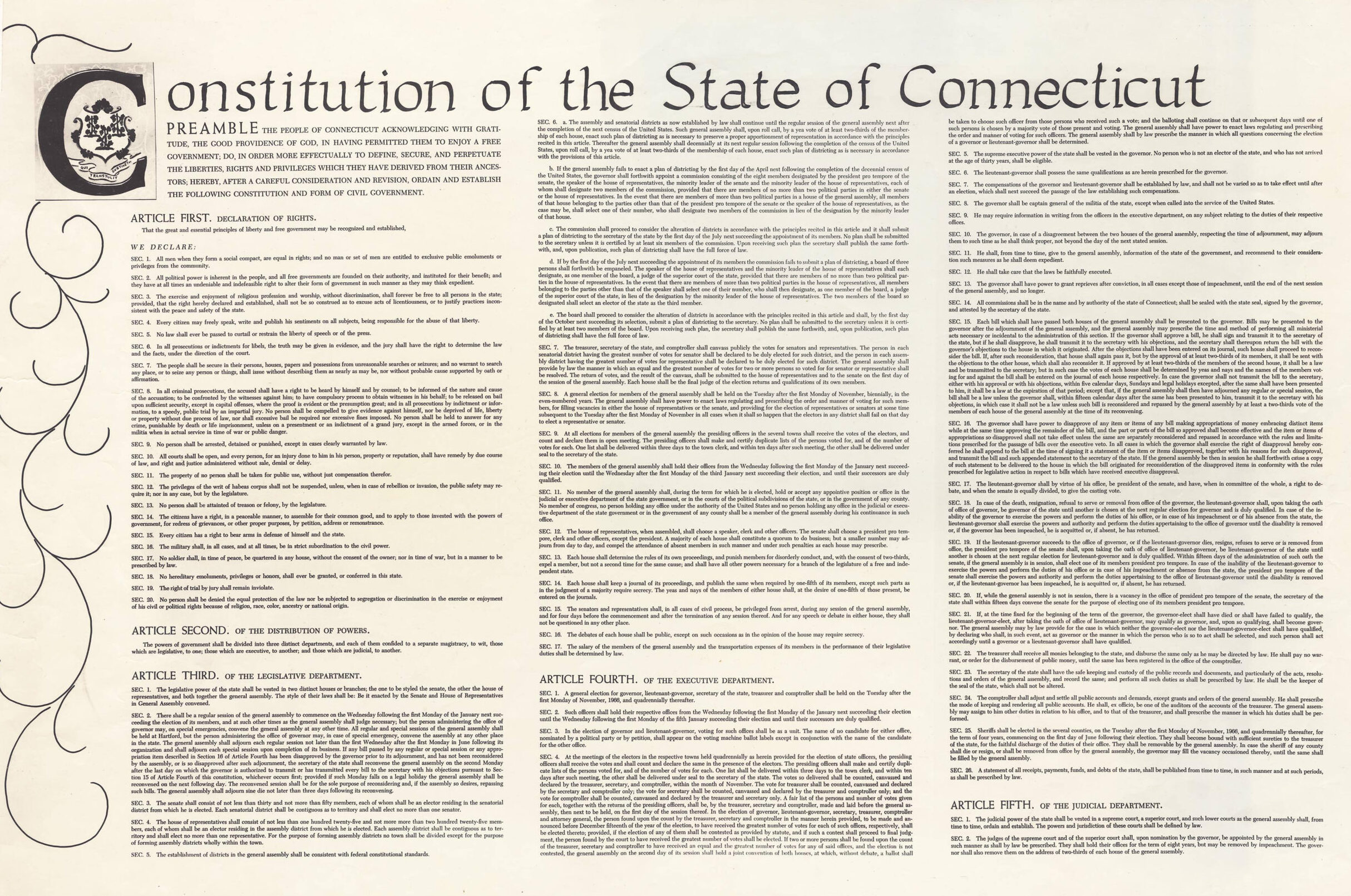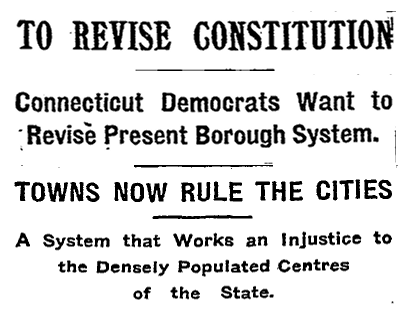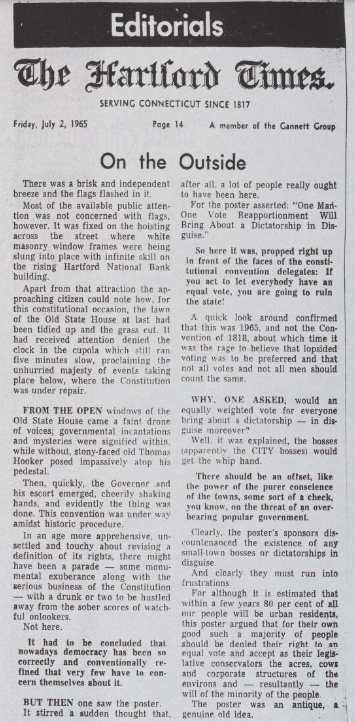TEACHER'S SNAPSHOT
Course Topics/Big Ideas:
Foundations of American Democracy, Rights and Responsibilities of Citizens
Town:
Hartford
Grade:
High School
Lesson Plan Notes
This lesson is the first part of a multi-part lesson on the Connecticut Constitution of 1965. While it is recommended that you start here to provide students with foundational understanding, feel free to do some or all of the parts in whatever order you see fit depending on your classroom needs. Each lesson individually should take a class period, but they could potentially be combined for a 2-3 week unit.
Students should have some prior knowledge of the US Constitution and the three branches of government.
Part Two: The Demand for Change: Federal Intervention and the 1965 Constitutional Convention
Part Three: The Right to an Education: Connecticut’s 1965 Education Amendment
Historic Background
Prior to 1965, Connecticut was governed by the Fundamental Orders, the Royal Charter, and the 1818 Constitution, which prioritized equal town representation in the legislature. This system persisted despite population shifts, leading to disparities in political power. U.S. Supreme Court rulings in the 1960s, emphasizing “one person, one vote,” challenged this system, and a lawsuit in 1964 led to a court mandate for a constitutional convention. The 1965 Connecticut Constitution shifted to population-based representation, significantly increasing representation for cities. This change addressed longstanding inequalities and fostered greater political inclusion. The new constitution also expanded religious freedom and established a right to free public education.
ESSENTIAL QUESTION
SUPPORTING QUESTIONS
- What was the system of representation in Connecticut before 1965?
- How did it count people for the purpose of political representation?
- What is the principle of “one person, one vote,” and why is it considered essential for a fair democracy?
ACTIVITY
- Divide students into two groups: have one group read the excerpted New York Times article “To Revise Constitution” (1900) and the other read The Hartford Times‘ “On the Outside” (1965). Both documents contain comprehension and critical thinking questions that students can answer alone, in pairs, or in even smaller groups.
- Then, assign one group to represent “Towns” and the other “Cities.” (You could even have smaller subgroups within these categories focusing on a specific type of town (e.g., agricultural, coastal) or city (e.g., industrial, port city) for more nuanced discussion.)
- Provide each group with a large sheet of paper, a whiteboard, or access to a digital document to create a T-chart. The left side of the T-chart should be labeled “Towns” and the right side labeled “Cities.”
- Instruct each group to brainstorm and fill out their respective sides of the T-chart, thinking about the common types of resources and industries found in each. What might be some key interests of people living in these areas related to these factors? How might legislation potentially affect them in different ways?
- Once the groups have had sufficient time to brainstorm, bring the class back together. Have representatives from each group share some of the key points from their T-charts. Facilitate a class discussion by asking questions like:
- What are some common themes that emerged for towns versus cities?
- Were there any areas where the interests of towns and cities might overlap?
- How might the state system of representation help or hurt these interests?
- Should small towns and big cities have equal power in government, or should it be based on the number of people? Why?
- Conclude by having students reflect on the articles and T-chart activity. What is the principle of “one person, one vote” and why is it important for representation? One article was written in 1900, the other in 1965—why do they think it took so long for change to occur?
OPPORTUNITIES FOR ASSESSMENT
Assessment Option 1: Essay
Write an argumentative essay in which you take the perspective of either a small town or a big city in Connecticut during the debate over the 1965 Constitution. Using at least three sources, analyze the key concerns, arguments, and political stakes for your chosen perspective.
- Clearly state the position of a small town or big city regarding the constitutional changes.
- Use historical evidence to support your argument.
- Address counterarguments from the opposing perspective.
- Conclude with an evaluation of how the 1965 Constitution changed Connecticut’s political landscape.
Assessment Option 2: Visual Representation
Students will analyze how representation changed after the 1965 Connecticut Constitution by tracking population shifts over time. Using this index, students will create visual representations (charts, graphs, or maps) to compare legislative representation before and after the “one person, one vote” principle was implemented.
- Choose one town and one city in Connecticut to research. Gather data on the following for each location from 1818 to 1965 and write a paragraph describing each location.
- Geography & Location: Is it rural, suburban, or urban?
- Population Over Time: How has the population grown or declined?
- Natural Resources & Industry: What economic factors shaped its development?
- Demographics: Consider factors such as industry, immigration, and major social changes.
- Legislative Representation: How was representation allocated in the General Assembly before 1965?
- Create a Side-by-Side Bar Chart: Create a bar chart comparing the approximate population of the chosen city and town before and after 1965. Below these bars, briefly note the change in the number of representatives each location would have had before and after the “one person, one vote” principle was implemented. For example, note that before 1965, both the city and town would have likely had the same (small) number of representatives, but after 1965, the city’s representation significantly increased while the town’s remained relatively stable or increased less dramatically in proportion to population change.
- Analyze and Explain: Students will then briefly explain their visual representation, focusing on:
- The population differences between the city and the town.
- How the system of equal town representation prior to 1965 did not reflect these population differences.
- How the 1965 Constitution, driven by the “one person, one vote” principle, led to a more proportional representation, benefiting more populous areas like cities.
RESOURCE TOOL KIT

Constitution of the State of Connecticut, 1965. Connecticut State Library Digital Collections.
Detailed Historical Background: this context may be helpful as you introduce students to the lesson.
Excerpt from “To Revise Constitution.” The New York Times, 16 September 1900.
This document also contains Comprehension and Critical Thinking questions for students.

Original print version of “To Revise Constitution.” The New York Times, 16 September 1900. The New York Times Article Archive.
“On the Outside.” The Hartford Times, 2 July 1965.
This document also contains Comprehension and Critical Thinking questions for students.

Original print version of “On the Outside.” The Hartford Times, 2 July 1965. Connecticut Digital Archive.
ADDITIONAL RESOURCES
Places to GO
Take your students on a tour of the Connecticut State Capitol, where they can learn about the legislative process while viewing the House and Senate chambers.
Visit Connecticut’s Old State House, which first opened its doors in 1796 on the site where Reverend Thomas Hooker delivered a sermon that inspired the Fundamental Orders, the basis of Connecticut’s first government. The Old State House was also the site of the 1965 Constitutional Convention and mentioned in the article “On the Outside.” Their program “History & Future of Voting Rights” is for grades 9-12.
Things To DO
Explore the Supreme Court and “one person, one vote” further with this lesson plan from Annenberg Classroom.
Websites to VISIT
Connecticut Constitutional History from the Connecticut State Library is a guide that provides resources related to Connecticut’s Founding Documents, the Constitution of 1818, and the Constitution of 1965.
Articles to READ
“The Constitutional Roots of Connecticut” by Steve Armstrong. Constituting America.
“Reflections on the 1965 Constitutional Convention” by Lawrence J. DeNardis. Connecticut Explored, Summer 2014.
“What would proportional representation look like in a state legislature?” Protect Democracy, Aug. 2024.



